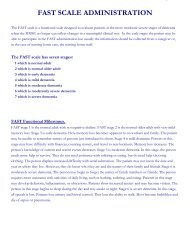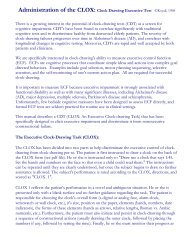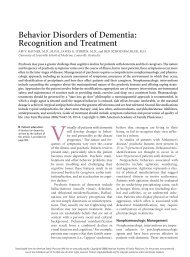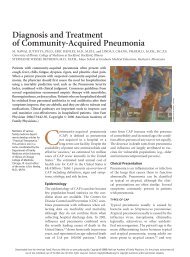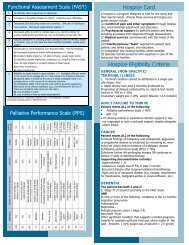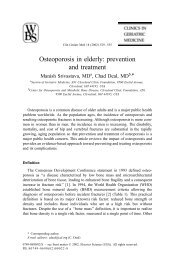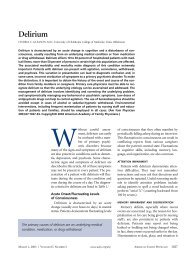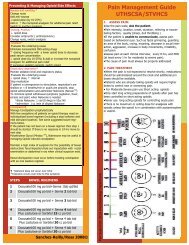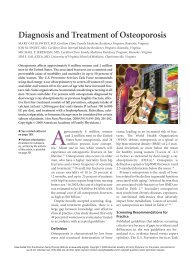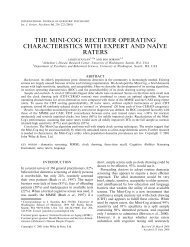Updating the Beers Criteria for Potentially Inappropriate Medication ...
Updating the Beers Criteria for Potentially Inappropriate Medication ...
Updating the Beers Criteria for Potentially Inappropriate Medication ...
You also want an ePaper? Increase the reach of your titles
YUMPU automatically turns print PDFs into web optimized ePapers that Google loves.
ORIGINAL INVESTIGATION<br />
<strong>Updating</strong> <strong>the</strong> <strong>Beers</strong> <strong>Criteria</strong> <strong>for</strong> <strong>Potentially</strong><br />
<strong>Inappropriate</strong> <strong>Medication</strong> Use in Older Adults<br />
Results of a US Consensus Panel of Experts<br />
Donna M. Fick, PhD, RN; James W. Cooper, PhD, RPh; William E. Wade, PharmD, FASHP, FCCP;<br />
Jennifer L. Waller, PhD; J. Ross Maclean, MD; Mark H. <strong>Beers</strong>, MD<br />
Background: <strong>Medication</strong> toxic effects and drugrelated<br />
problems can have profound medical and safety<br />
consequences <strong>for</strong> older adults and economically affect <strong>the</strong><br />
health care system. The purpose of this initiative was to<br />
revise and update <strong>the</strong> <strong>Beers</strong> criteria <strong>for</strong> potentially inappropriate<br />
medication use in adults 65 years and older in<br />
<strong>the</strong> United States.<br />
Methods: This study used a modified Delphi method, a<br />
set of procedures and methods <strong>for</strong> <strong>for</strong>mulating a group judgment<br />
<strong>for</strong> a subject matter in which precise in<strong>for</strong>mation is<br />
lacking. The criteria reviewed covered 2 types of statements:<br />
(1) medications or medication classes that should<br />
generally be avoided in persons 65 years or older because<br />
<strong>the</strong>y are ei<strong>the</strong>r ineffective or <strong>the</strong>y pose unnecessarily high<br />
risk <strong>for</strong> older persons and a safer alternative is available and<br />
(2) medications that should not be used in older persons<br />
known to have specific medical conditions.<br />
Results: This study identified 48 individual medications<br />
or classes of medications to avoid in older adults<br />
and <strong>the</strong>ir potential concerns and 20 diseases/conditions<br />
and medications to be avoided in older adults with <strong>the</strong>se<br />
conditions. Of <strong>the</strong>se potentially inappropriate drugs, 66<br />
were considered by <strong>the</strong> panel to have adverse outcomes<br />
of high severity.<br />
Conclusions: This study is an important update of previously<br />
established criteria that have been widely used<br />
and cited. The application of <strong>the</strong> <strong>Beers</strong> criteria and o<strong>the</strong>r<br />
tools <strong>for</strong> identifying potentially inappropriate medication<br />
use will continue to enable providers to plan interventions<br />
<strong>for</strong> decreasing both drug-related costs and overall<br />
costs and thus minimize drug-related problems.<br />
Arch Intern Med. 2003;163:2716-2724<br />
From <strong>the</strong> Department of<br />
Medicine, Center <strong>for</strong> Health<br />
Care Improvement (Drs Fick<br />
and Maclean); and Office of<br />
Biostatistics (Dr Waller),<br />
Medical College of Georgia,<br />
Augusta; Department of<br />
Veterans Affairs Medical<br />
Center, Augusta (Dr Fick);<br />
Department of Clinical and<br />
Administrative Pharmacy,<br />
College of Pharmacy,<br />
University of Georgia, A<strong>the</strong>ns,<br />
(Drs Cooper and Wade); and<br />
Merck & Co Inc, West Point,<br />
Pa (Dr <strong>Beers</strong>). The authors<br />
have no relevant financial<br />
interest in this article.<br />
TOXIC EFFECTS of medications<br />
and drug-related problems<br />
can have profound<br />
medical and safety consequences<br />
<strong>for</strong> older adults and<br />
economically effect <strong>the</strong> health care system.<br />
Thirty percent of hospital admissions<br />
in elderly patients may be linked to drugrelated<br />
problems or drug toxic effects. 1 Adverse<br />
drug events (ADEs) have been linked<br />
to preventable problems in elderly patients<br />
such as depression, constipation, falls,<br />
immobility, confusion, and hip fractures.<br />
1,2 A 1997 study of ADEs found that<br />
35% of ambulatory older adults experienced<br />
an ADE and 29% required health care<br />
services (physician, emergency department,<br />
or hospitalization) <strong>for</strong> <strong>the</strong> ADE. 1 Some<br />
two thirds of nursing facility residents have<br />
ADEs over a 4-year period. 3 Of <strong>the</strong>se ADEs,<br />
1 in 7 results in hospitalization. 4<br />
Recent estimates of <strong>the</strong> overall human<br />
and economic consequences of medication-related<br />
problems vastly exceed <strong>the</strong><br />
findings of <strong>the</strong> Institute of Medicine (IOM)<br />
on deaths from medical errors, estimated<br />
to cost <strong>the</strong> nation $8 billion annually. 5 In<br />
2000, it is estimated that medicationrelated<br />
problems caused 106000 deaths<br />
annually at a cost of $85 billion. 6 O<strong>the</strong>rs<br />
have calculated <strong>the</strong> cost of medicationrelated<br />
problems to be $76.6 billion to ambulatory<br />
care, $20 billion to hospitals, and<br />
$4 billion to nursing home facilities. 2,7,8 If<br />
medication-related problems were ranked<br />
as a disease by cause of death, it would be<br />
<strong>the</strong> fifth leading cause of death in <strong>the</strong><br />
United States. 9 The prevention and recognition<br />
of drug-related problems in elderly<br />
patients and o<strong>the</strong>r vulnerable populations<br />
is one of <strong>the</strong> principal health care<br />
quality and safety issues <strong>for</strong> this decade.<br />
CME course available at<br />
www.archinternmed.com<br />
The a<strong>for</strong>ementioned IOM report has<br />
focused increased attention on finding solutions<br />
<strong>for</strong> unsafe medication practices,<br />
polypharmacy, and drug-related problems<br />
in <strong>the</strong> care of older adults. There are many<br />
ways to define medication-related prob-<br />
ARCH INTERN MED/ VOL 163, DEC 8/22, 2003 WWW.ARCHINTERNMED.COM<br />
2716<br />
Downloaded from ©2003 www.archinternmed.com American Medical at Association. Univ. of TX HSC All rights at San reserved. Antonio, on July 8, 2008<br />
(REPRINTED WITH CORRECTIONS)
lems in elderly patients, including <strong>the</strong> use of lists containing<br />
specific drugs to avoid in <strong>the</strong> elderly and appropriateness<br />
indexes applied by pharmacists or clinicians. 1,10,11<br />
Systematic review of <strong>the</strong> evidence-based literature on medication<br />
use in elderly patients is ano<strong>the</strong>r approach to defining<br />
<strong>the</strong> problem, but <strong>the</strong> number of controlled studies<br />
on medication use in elderly patients is limited.<br />
The use of consensus criteria <strong>for</strong> safe medication use<br />
in elderly patients is one approach to developing reliable<br />
and explicit criteria when precise clinical in<strong>for</strong>mation is<br />
lacking. The two most widely used consensus criteria <strong>for</strong><br />
medication use in older adults are <strong>the</strong> <strong>Beers</strong> criteria and<br />
<strong>the</strong> Canadian criteria. 12-14 The <strong>Beers</strong> criteria are based on<br />
expert consensus developed through an extensive literature<br />
review with a bibliography and questionnaire evaluated<br />
by nationally recognized experts in geriatric care,<br />
clinical pharmacology, and psychopharmacology using a<br />
modified Delphi technique to reach consensus. The<br />
<strong>Beers</strong> criteria have been used to survey clinical medication<br />
use, analyze computerized administrative data sets,<br />
and evaluate intervention studies to decrease medication<br />
problems in older adults. The <strong>Beers</strong> criteria were also<br />
adopted by <strong>the</strong> Centers <strong>for</strong> Medicare & Medicaid Services<br />
(CMS) in July 1999 <strong>for</strong> nursing home regulation.<br />
Previous studies have shown <strong>the</strong>se criteria to be useful<br />
in decreasing problems in older adults. 15-19 These criteria,<br />
though controversial at times, have been widely used<br />
over <strong>the</strong> past 10 years <strong>for</strong> studying prescribing patterns<br />
within populations, educating clinicians, and evaluating<br />
health outcomes, cost, and utilization data. 20-23<br />
A recently published study of potentially inappropriate<br />
medication (PIM) use with <strong>the</strong> <strong>Beers</strong> criteria in a<br />
Medicare-managed care population found a PIM prevalence<br />
of 23% (541/2336). Those receiving a PIM had significantly<br />
higher total, provider, and facility costs and a<br />
higher mean number of inpatient, outpatient, and emergency<br />
department visits than comparisons after controlling<br />
<strong>for</strong> sex, Charlson Comorbidity Index, and total number<br />
of prescriptions. 20 O<strong>the</strong>r studies have found that specific<br />
PIMs such as nonsteroidal anti-inflammatory drugs<br />
(NSAIDs) and benzodiazepines have been associated with<br />
adverse outcomes and increased costs. 18 In contrast, a recent<br />
study on <strong>the</strong> relationship between inappropriate drug<br />
use, functional status decline, and mortality in 3234 patients<br />
from <strong>the</strong> Duke cohort did not find an association<br />
with mortality and inappropriate drug use as determined<br />
by <strong>the</strong> <strong>Beers</strong> criteria after controlling <strong>for</strong> covariates. 24<br />
In summary, <strong>the</strong>se criteria have been used extensively<br />
<strong>for</strong> evaluating and intervening in medication use<br />
in older adults over <strong>the</strong> past decade. However, with <strong>the</strong><br />
continuous arrival of new drugs on <strong>the</strong> market, increased<br />
knowledge about older drugs, and removal of<br />
older drugs from <strong>the</strong> market, <strong>the</strong>se criteria must be updated<br />
on a regular basis to remain useful. Since <strong>the</strong> criteria<br />
were published in 1997, <strong>the</strong>re has been an increase<br />
in <strong>the</strong> number of scientific studies addressing drug use<br />
and appropriateness in older adults, but <strong>the</strong>re is still a<br />
lack of controlled studies in <strong>the</strong> older population and particularly<br />
in patients older than 75 years and patients with<br />
multiple comorbidities. 23<br />
The purpose of this initiative was to revise and<br />
update <strong>the</strong> <strong>Beers</strong> criteria <strong>for</strong> ambulatory and nursing<br />
Below are <strong>the</strong> <strong>Beers</strong> criteria published in 1997. In parts 1 and 2, we are first<br />
asking you to rate your level of agreement on <strong>the</strong>se 1997 criteria.<br />
Please answer <strong>the</strong> following questions regarding <strong>the</strong> use of medications in adults<br />
65 years or older:<br />
Please give one of <strong>the</strong> following answers:<br />
1=Strongly Agree 2=Agree 3=Unsure 4=Disagree 5=Strongly Disagree<br />
0=Unable to offer an opinion<br />
1) Propoxyphene (Darvon) and combination products (Darvon with ASA,<br />
Darvon-N, and Darvocet-N) should be avoided.<br />
1 2 3 4 5 0<br />
Sample survey question.<br />
facility populations older than 65 years in <strong>the</strong> United<br />
States. There were 3 main aims: (1) to reevaluate <strong>the</strong><br />
1997 criteria to include new products and incorporate<br />
new in<strong>for</strong>mation available from <strong>the</strong> scientific literature,<br />
(2) to assign or reevaluate a relative rating of severity<br />
<strong>for</strong> each of <strong>the</strong> medications, and (3) to identify any new<br />
conditions or considerations not addressed in <strong>the</strong> 1997<br />
criteria.<br />
METHODS<br />
There were 5 phases in <strong>the</strong> data collection <strong>for</strong> this study: (1)<br />
<strong>the</strong> review of <strong>the</strong> literature, (2) creation and mailing of <strong>the</strong> round<br />
1 questionnaire, (3) creation of <strong>the</strong> second-round questionnaire<br />
based on round 1 and expert panel feedback, (4) convening<br />
of <strong>the</strong> expert panel and panel responses to <strong>the</strong> secondround<br />
questionnaire, and (5) completion and analysis of a third<br />
and final mailed questionnaire that measured <strong>the</strong> severity ratings<br />
of <strong>the</strong> PIMs to create <strong>the</strong> final revised list.<br />
The criteria reviewed covered 2 types of statements: (1)<br />
medications or medication classes that should generally be<br />
avoided in persons 65 years or older because <strong>the</strong>y are ei<strong>the</strong>r<br />
ineffective or <strong>the</strong>y pose unnecessarily high risk <strong>for</strong> older persons<br />
and a safer alternative is available and (2) medications<br />
that should not be used in older persons known to have specific<br />
medical conditions. The 2 statements each used a 5-point<br />
Likert scale and ask respondents to rate <strong>the</strong>ir agreement or disagreement<br />
with <strong>the</strong> statement from strongly agree (1) to<br />
strongly disagree (5), with <strong>the</strong> midpoint (3) expressing equivocation.<br />
The second type of question asked <strong>the</strong> respondents to<br />
evaluate <strong>the</strong> medication appropriateness given certain conditions<br />
or diagnoses (Figure). All questions included an option<br />
to not answer if <strong>the</strong> respondent did not feel qualified to<br />
answer. This methodology was similar to that used by <strong>Beers</strong> et<br />
al 13 in <strong>the</strong> creation of <strong>the</strong> first 2 iterations of <strong>the</strong> criteria. The<br />
methodology used in <strong>the</strong> third iteration of <strong>the</strong> <strong>Beers</strong> criteria<br />
only differed in <strong>the</strong> number of panelists (13 in 1991; 6 in<br />
1997; and 12 in 2002) and <strong>the</strong> use of a third-round survey <strong>for</strong><br />
<strong>the</strong> severity ratings, which was done (in person) in <strong>the</strong> 1997<br />
update of <strong>the</strong> criteria.<br />
RESEARCH DESIGN<br />
The modified Delphi method is a technique to arrive at a group<br />
consensus regarding an issue under investigation that was originally<br />
developed at <strong>the</strong> RAND Corporation (Santa Monica, Calif)<br />
by Olaf Helmer and Norman Dalkey. 25 The Delphi method is a<br />
set of procedures and methods <strong>for</strong> <strong>for</strong>mulating a group judgment<br />
<strong>for</strong> a subject matter in which precise in<strong>for</strong>mation is lacking<br />
(such as medication use in older adults). The Delphi method<br />
provides a means to reach consensus within a group of experts.<br />
The method relies on soliciting individual (often anonymous)<br />
answers to written questions by survey or o<strong>the</strong>r type of<br />
ARCH INTERN MED/ VOL 163, DEC 8/22, 2003 WWW.ARCHINTERNMED.COM<br />
2717<br />
Downloaded from ©2003 www.archinternmed.com American Medical at Association. Univ. of TX HSC All rights at San reserved. Antonio, on July 8, 2008<br />
(REPRINTED WITH CORRECTIONS)
communication. A series of iterations provides each individual<br />
with feedback on <strong>the</strong> responses of <strong>the</strong> o<strong>the</strong>rs in <strong>the</strong> group.<br />
The final responses are evaluated <strong>for</strong> variance and means to determine<br />
which questions <strong>the</strong> group has reached consensus about,<br />
ei<strong>the</strong>r affirmatively or negatively.<br />
LITERATURE REVIEW<br />
The selection of articles <strong>for</strong> <strong>for</strong>mulating <strong>the</strong> survey involved 3<br />
steps and was phase 1 of <strong>the</strong> study. First, we identified literature<br />
published since January 1994 in English, describing or<br />
analyzing medication use in community-living (ambulatory)<br />
older adults and older adults living in nursing homes. From<br />
that, we created a table and bibliography. We used MEDLINE,<br />
searching with <strong>the</strong> following key terms adverse drug reactions,<br />
adverse drug events, medication problems, and medications and<br />
elderly <strong>for</strong> all relevant articles published between January 1994<br />
and December 2000. Second, we hand searched and identified<br />
additional references from <strong>the</strong> bibliographies of relevant<br />
articles. Third, all <strong>the</strong> panelists were invited to add references<br />
and articles after <strong>the</strong> first survey to add to <strong>the</strong> literature review.<br />
Each study was systematically reviewed by 2 investigators<br />
using a table to outline <strong>the</strong> following in<strong>for</strong>mation: type of<br />
study design; sample size; medications reviewed; summary of<br />
results and key points; quality, type and category of medication<br />
addressed; and severity of <strong>the</strong> drug-related problem.<br />
EXPERT PANEL SELECTION<br />
The panel of members were invited to participate via letter by<br />
<strong>the</strong> 4 investigators and a consultant and represented a variety of<br />
experience and judgment including extensive clinical practice,<br />
extensive publications in this area, and/or senior academic rank.<br />
They were also chosen to represent acute, long-term, and community<br />
practice settings with pharmacological, geriatric medicine,<br />
and psychiatric expertise. Lastly, <strong>the</strong>y were selected from<br />
geographically diverse parts of <strong>the</strong> United States. We initially invited<br />
(via regular mail) 16 potential participants with nationally<br />
and/or internationally recognized expertise in psychopharmacology,<br />
pharmacoepidemiology, clinical geriatric<br />
pharmacology, and clinical geriatric medicine to complete our<br />
survey. Our response rate <strong>for</strong> <strong>the</strong> initial invitation to participate<br />
as a panelist was 75% (12/16). Our final panel thus consisted of<br />
12 experts who completed all rounds of <strong>the</strong> survey.<br />
DATA COLLECTION<br />
AND ANALYSIS<br />
We used <strong>the</strong> systematic review of <strong>the</strong> literature to construct <strong>the</strong><br />
first round questionnaire. The first-round survey contained<br />
4 sections. Parts 1 and 2 reviewed <strong>the</strong> latest 1997 criteria. Parts<br />
3 and 4 were medications added <strong>for</strong> <strong>the</strong> 2002 update <strong>for</strong> medications<br />
alone (part 3) and medications considering diagnoses<br />
and conditions. Parts 3 and 4 included 29 new questions about<br />
medications or medication classes and conditions. The last question<br />
in part 4 asked panel members to add medications to <strong>the</strong><br />
list. The panel was <strong>the</strong>n surveyed via Delphi technique to determine<br />
concordance/consensus with <strong>the</strong> round 1 survey and<br />
invited to add additional medications prior to and during <strong>the</strong><br />
second-round meeting.<br />
We created <strong>the</strong> second and third questionnaires (severity<br />
ratings) from panel input and <strong>the</strong> results of <strong>the</strong> previous round<br />
survey. We completed all mailed and face-to-face rounds between<br />
October 2001 and February 2002. We constructed <strong>the</strong><br />
questionnaire statements according to <strong>the</strong> original <strong>Beers</strong> criteria<br />
published in 1991 and <strong>the</strong> updated criteria published in<br />
1997. The instructions accompanying <strong>the</strong> survey asked <strong>the</strong> respondents<br />
to consider <strong>the</strong> use of medications only in adults 65<br />
years and older. The second-round survey included <strong>the</strong> statements<br />
included from round 1 and any statements added by <strong>the</strong><br />
experts from <strong>the</strong> first round. In <strong>the</strong> second round and <strong>the</strong> faceto-face<br />
meeting, <strong>the</strong> respondents were given in<strong>for</strong>mation about<br />
<strong>the</strong>ir answers and <strong>the</strong> anonymous answers of <strong>the</strong> o<strong>the</strong>r members<br />
of <strong>the</strong> group and were given <strong>the</strong> opportunity to reconsider<br />
<strong>the</strong>ir previous response.<br />
After analyzing <strong>the</strong> responses from <strong>the</strong> first round of <strong>the</strong><br />
survey, we examined each question <strong>for</strong> inclusion or exclusion<br />
in <strong>the</strong> revised criteria or <strong>for</strong> fur<strong>the</strong>r consideration in <strong>the</strong> second<br />
round of <strong>the</strong> survey. We calculated <strong>the</strong> mean rating and<br />
corresponding 95% confidence interval (CI) of each statement<br />
or dosing question collected from <strong>the</strong> first round of <strong>the</strong><br />
survey. Those statements whose upper limit of <strong>the</strong> 95% CI<br />
was less than 3.0 were included in <strong>the</strong> updated criteria. Those<br />
statements or dosing questions whose lower limit of <strong>the</strong> 95%<br />
CI was greater than 3.0 were excluded from <strong>the</strong> updated criteria.<br />
Statements whose 95% CI included <strong>the</strong> value of 3.0 were<br />
included <strong>for</strong> fur<strong>the</strong>r determination in <strong>the</strong> second-round faceto-face<br />
meeting.<br />
The face-to-face meeting was convened on December 10,<br />
2001, in Atlanta, Ga. Each panel member was given <strong>the</strong> results<br />
of <strong>the</strong> first-round survey and <strong>the</strong> added medications (from<br />
<strong>the</strong> o<strong>the</strong>r panel members) to review approximately 10 days be<strong>for</strong>e<br />
<strong>the</strong> meeting. For statements that needed fur<strong>the</strong>r examination<br />
(nei<strong>the</strong>r included or excluded during round 1), each rater<br />
was given his or her previous rating and <strong>the</strong> mean rating of <strong>the</strong><br />
group of experts in <strong>the</strong> second survey.<br />
Any additional statements or dosing questions that had<br />
been made on <strong>the</strong> open-ended portion of <strong>the</strong> first round of <strong>the</strong><br />
survey by any expert was included in <strong>the</strong> survey <strong>for</strong> <strong>the</strong> second<br />
round. Forty-four questions were added by expert panelists<br />
during round 1 of <strong>the</strong> survey, and 9 questions were added<br />
during <strong>the</strong> round 2 in-person survey and voted on during <strong>the</strong><br />
in-person meeting. These questions/medications made up part<br />
5 of <strong>the</strong> survey. Twenty-four questions from parts 3 and 4 had<br />
95% CIs greater than 3.0 after <strong>the</strong> round 1 survey. During <strong>the</strong><br />
second-round face-to-face meeting, <strong>the</strong> group debated <strong>the</strong>se remaining<br />
statements and <strong>the</strong>n rerated <strong>the</strong>m using <strong>the</strong> same Likert<br />
scale. The mean rating and 95% CI were calculated. The technique<br />
used <strong>for</strong> <strong>the</strong> first round <strong>for</strong> inclusion or exclusion of <strong>the</strong><br />
statement or dosing question in <strong>the</strong> updated criteria was used.<br />
Those statements whose 95% CI included 3.0 were excluded<br />
from <strong>the</strong> updated criteria. Lastly, in January 2002, we surveyed<br />
panelists on a 5-point scale <strong>for</strong> <strong>the</strong> severity of <strong>the</strong> potential<br />
medication problem.<br />
RESULTS<br />
The final criteria are listed in Table 1 and Table 2. Table<br />
1 contains 48 individual medications or classes of medications<br />
to avoid in older adults and <strong>the</strong>ir potential concerns.<br />
Table 2 lists 20 diseases or conditions and medications<br />
to be avoided in older adults with <strong>the</strong>se conditions.<br />
Sixty-six of <strong>the</strong>se potentially inappropriate drugs were<br />
considered by <strong>the</strong> panel to have adverse outcomes of high<br />
severity. New conditions and diagnoses that were addressed<br />
this time included depression, cognitive impairment,<br />
Parkinson disease, anorexia, and malnutrition, syndrome<br />
of inappropriate antidiuretic hormone secretion,<br />
and obesity.<br />
A total of 15 medications/medication classes were<br />
dropped or modified from <strong>the</strong> 1997 to <strong>the</strong> 2002 update from<br />
<strong>the</strong> round 1 survey. Most of <strong>the</strong> medications dropped since<br />
1997 were those that were associated with diagnoses or conditions.<br />
The following medications were voted to be dropped<br />
ARCH INTERN MED/ VOL 163, DEC 8/22, 2003 WWW.ARCHINTERNMED.COM<br />
2718<br />
Downloaded from ©2003 www.archinternmed.com American Medical at Association. Univ. of TX HSC All rights at San reserved. Antonio, on July 8, 2008<br />
(REPRINTED WITH CORRECTIONS)
Table 1. 2002 <strong>Criteria</strong> <strong>for</strong> <strong>Potentially</strong> <strong>Inappropriate</strong> <strong>Medication</strong> Use in Older Adults: Independent of Diagnoses or Conditions<br />
Drug<br />
Propoxyphene (Darvon) and combination products<br />
(Darvon with ASA, Darvon-N, and Darvocet-N)<br />
Indomethacin (Indocin and Indocin SR)<br />
Pentazocine (Talwin)<br />
Trimethobenzamide (Tigan)<br />
Muscle relaxants and antispasmodics: methocarbamol<br />
(Robaxin), carisoprodol (Soma), chlorzoxazone (Paraflex),<br />
metaxalone (Skelaxin), cyclobenzaprine (Flexeril), and<br />
oxybutynin (Ditropan). Do not consider <strong>the</strong> extended-release<br />
Ditropan XL.<br />
Flurazepam (Dalmane)<br />
Amitriptyline (Elavil), chlordiazepoxide-amitriptyline (Limbitrol),<br />
and perphenazine-amitriptyline (Triavil)<br />
Doxepin (Sinequan)<br />
Meprobamate (Miltown and Equanil)<br />
Doses of short-acting benzodiazepines: doses greater than<br />
lorazepam (Ativan), 3 mg; oxazepam (Serax), 60 mg;<br />
alprazolam (Xanax), 2 mg; temazepam (Restoril), 15 mg;<br />
and triazolam (Halcion), 0.25 mg<br />
Long-acting benzodiazepines: chlordiazepoxide (Librium),<br />
chlordiazepoxide-amitriptyline (Limbitrol)<br />
clidinium-chlordiazepoxide (Librax), diazepam (Valium),<br />
quazepam (Doral), halazepam (Paxipam), and chlorazepate<br />
(Tranxene)<br />
Disopyramide (Norpace and Norpace CR)<br />
Concern<br />
Offers few analgesic advantages over acetaminophen, yet has <strong>the</strong> adverse<br />
effects of o<strong>the</strong>r narcotic drugs.<br />
Of all available nonsteroidal anti-inflammatory drugs, this drug produces<br />
<strong>the</strong> most CNS adverse effects.<br />
Narcotic analgesic that causes more CNS adverse effects, including<br />
confusion and hallucinations, more commonly than o<strong>the</strong>r narcotic<br />
drugs. Additionally, it is a mixed agonist and antagonist.<br />
One of <strong>the</strong> least effective antiemetic drugs, yet it can cause extrapyramidal<br />
adverse effects.<br />
Most muscle relaxants and antispasmodic drugs are poorly tolerated by<br />
elderly patients, since <strong>the</strong>se cause anticholinergic adverse effects,<br />
sedation, and weakness. Additionally, <strong>the</strong>ir effectiveness at doses<br />
tolerated by elderly patients is questionable.<br />
This benzodiazepine hypnotic has an extremely long half-life in elderly<br />
patients (often days), producing prolonged sedation and increasing <strong>the</strong><br />
incidence of falls and fracture. Medium- or short-acting<br />
benzodiazepines are preferable.<br />
Because of its strong anticholinergic and sedation properties, amitriptyline<br />
is rarely <strong>the</strong> antidepressant of choice <strong>for</strong> elderly patients.<br />
Because of its strong anticholinergic and sedating properties, doxepin is<br />
rarely <strong>the</strong> antidepressant of choice <strong>for</strong> elderly patients.<br />
This is a highly addictive and sedating anxiolytic. Those using<br />
meprobamate <strong>for</strong> prolonged periods may become addicted and may<br />
need to be withdrawn slowly.<br />
Because of increased sensitivity to benzoadiazepines in elderly patients,<br />
smaller doses may be effective as well as safer. Total daily doses should<br />
rarely exceed <strong>the</strong> suggested maximums.<br />
These drugs have a long half-life in elderly patients (often several days),<br />
producing prolonged sedation and increasing <strong>the</strong> risk of falls and<br />
fractures. Short- and intermediate-acting benzodiazepines are preferred<br />
if a benzodiazepine is required.<br />
Of all antiarrhythmic drugs, this is <strong>the</strong> most potent negative inotrope and<br />
<strong>the</strong>re<strong>for</strong>e may induce heart failure in elderly patients. It is also strongly<br />
anticholinergic. O<strong>the</strong>r antiarrhythmic drugs should be used.<br />
Decreased renal clearance may lead to increased risk of toxic effects.<br />
Severity Rating<br />
(High or Low)<br />
Digoxin (Lanoxin) (should not exceed 0.125 mg/d except when<br />
Low<br />
treating atrial arrhythmias)<br />
Short-acting dipyridamole (Persantine). Do not consider <strong>the</strong> May cause orthostatic hypotension.<br />
Low<br />
long-acting dipyridamole (which has better properties than <strong>the</strong><br />
short-acting in older adults) except with patients with artificial<br />
heart valves<br />
Methyldopa (Aldomet) and methyldopa-hydrochlorothiazide May cause bradycardia and exacerbate depression in elderly patients.<br />
High<br />
(Aldoril)<br />
Reserpine at doses 0.25 mg May induce depression, impotence, sedation, and orthostatic hypotension. Low<br />
Chlorpropamide (Diabinese)<br />
It has a prolonged half-life in elderly patients and could cause prolonged High<br />
hypoglycemia. Additionally, it is <strong>the</strong> only oral hypoglycemic agent that<br />
causes SIADH.<br />
Gastrointestinal antispasmodic drugs: dicyclomine (Bentyl),<br />
hyoscyamine (Levsin and Levsinex), propan<strong>the</strong>line<br />
(Pro-Banthine), belladonna alkaloids (Donnatal and o<strong>the</strong>rs),<br />
and clidinium-chlordiazepoxide (Librax)<br />
Anticholinergics and antihistamines: chlorpheniramine<br />
(Chlor-Trimeton), diphenhydramine (Benadryl), hydroxyzine<br />
(Vistaril and Atarax), cyproheptadine (Periactin), promethazine<br />
(Phenergan), tripelennamine, dexchlorpheniramine<br />
(Polaramine)<br />
Diphenhydramine (Benadryl)<br />
GI antispasmodic drugs are highly anticholinergic and have uncertain<br />
effectiveness. These drugs should be avoided (especially <strong>for</strong><br />
long-term use).<br />
All nonprescription and many prescription antihistamines may have potent<br />
anticholinergic properties. Nonanticholinergic antihistamines are<br />
preferred in elderly patients when treating allergic reactions.<br />
May cause confusion and sedation. Should not be used as a hypnotic, and<br />
when used to treat emergency allergic reactions, it should be used in<br />
<strong>the</strong> smallest possible dose.<br />
Ergot mesyloids (Hydergine) and cyclandelate (Cyclospasmol) Have not been shown to be effective in <strong>the</strong> doses studied. Low<br />
Ferrous sulfate 325 mg/d<br />
Doses 325 mg/d do not dramatically increase <strong>the</strong> amount absorbed but Low<br />
greatly increase <strong>the</strong> incidence of constipation.<br />
All barbiturates (except phenobarbital) except when used to<br />
control seizures<br />
Are highly addictive and cause more adverse effects than most sedative or<br />
hypnotic drugs in elderly patients.<br />
High<br />
Low<br />
High<br />
High<br />
High<br />
High<br />
High<br />
High<br />
High<br />
High<br />
High<br />
High<br />
High<br />
High<br />
High<br />
High<br />
(continued)<br />
ARCH INTERN MED/ VOL 163, DEC 8/22, 2003 WWW.ARCHINTERNMED.COM<br />
2719<br />
Downloaded from ©2003 www.archinternmed.com American Medical at Association. Univ. of TX HSC All rights at San reserved. Antonio, on July 8, 2008<br />
(REPRINTED WITH CORRECTIONS)
Table 1. 2002 <strong>Criteria</strong> <strong>for</strong> <strong>Potentially</strong> <strong>Inappropriate</strong> <strong>Medication</strong> Use in Older Adults: Independent of Diagnoses or Conditions (cont)<br />
Drug<br />
Meperidine (Demerol)<br />
Ticlopidine (Ticlid)<br />
Ketorolac (Toradol)<br />
Amphetamines and anorexic agents<br />
Long-term use of full-dosage, longer half-life,<br />
non–COX-selective NSAIDs: naproxen (Naprosyn, Avaprox,<br />
and Aleve), oxaprozin (Daypro), and piroxicam (Feldene)<br />
Daily fluoxetine (Prozac)<br />
Long-term use of stimulant laxatives: bisacodyl (Dulcolax),<br />
cascara sagrada, and Neoloid except in <strong>the</strong> presence of opiate<br />
analgesic use<br />
Amiodarone (Cordarone)<br />
Concern<br />
Not an effective oral analgesic in doses commonly used. May cause<br />
confusion and has many disadvantages to o<strong>the</strong>r narcotic drugs.<br />
Has been shown to be no better than aspirin in preventing clotting and<br />
may be considerably more toxic. Safer, more effective alternatives<br />
exist.<br />
Immediate and long-term use should be avoided in older persons, since<br />
a significant number have asymptomatic GI pathologic conditions.<br />
These drugs have potential <strong>for</strong> causing dependence, hypertension,<br />
angina, and myocardial infarction.<br />
Have <strong>the</strong> potential to produce GI bleeding, renal failure, high blood<br />
pressure, and heart failure.<br />
Long half-life of drug and risk of producing excessive CNS stimulation,<br />
sleep disturbances, and increasing agitation. Safer alternatives exist.<br />
May exacerbate bowel dysfunction.<br />
Severity Rating<br />
(High or Low)<br />
Associated with QT interval problems and risk of provoking torsades de High<br />
pointes. Lack of efficacy in older adults.<br />
Orphenadrine (Norflex)<br />
Causes more sedation and anticholinergic adverse effects than safer<br />
High<br />
alternatives.<br />
Guanethidine (Ismelin) May cause orthostatic hypotension. Safer alternatives exist. High<br />
Guanadrel (Hylorel) May cause orthostatic hypotension. High<br />
Cyclandelate (Cyclospasmol) Lack of efficacy. Low<br />
Isoxsurpine (Vasodilan) Lack of efficacy. Low<br />
Nitrofurantoin (Macrodantin) Potential <strong>for</strong> renal impairment. Safer alternatives available. High<br />
Doxazosin (Cardura) Potential <strong>for</strong> hypotension, dry mouth, and urinary problems. Low<br />
Methyltestosterone (Android, Virilon, and Testrad) Potential <strong>for</strong> prostatic hypertrophy and cardiac problems. High<br />
Thioridazine (Mellaril) Greater potential <strong>for</strong> CNS and extrapyramidal adverse effects. High<br />
Mesoridazine (Serentil) CNS and extrapyramidal adverse effects. High<br />
Short acting nifedipine (Procardia and Adalat) Potential <strong>for</strong> hypotension and constipation. High<br />
Clonidine (Catapres) Potential <strong>for</strong> orthostatic hypotension and CNS adverse effects. Low<br />
Mineral oil Potential <strong>for</strong> aspiration and adverse effects. Safer alternatives available. High<br />
Cimetidine (Tagamet) CNS adverse effects including confusion. Low<br />
Ethacrynic acid (Edecrin)<br />
Potential <strong>for</strong> hypertension and fluid imbalances. Safer alternatives<br />
Low<br />
available.<br />
Desiccated thyroid Concerns about cardiac effects. Safer alternatives available. High<br />
Amphetamines (excluding methylphenidate hydrochloride CNS stimulant adverse effects.<br />
High<br />
and anorexics)<br />
Estrogens only (oral)<br />
Evidence of <strong>the</strong> carcinogenic (breast and endometrial cancer) potential<br />
of <strong>the</strong>se agents and lack of cardioprotective effect in older women.<br />
Low<br />
Abbreviations: CNS, central nervous system; COX, cyclooxygenase; GI, gastrointestinal; NSAIDs, nonsteroidal anti-inflammatory drugs; SIADH, syndrome of<br />
inappropriate antidiuretic hormone secretion.<br />
High<br />
High<br />
High<br />
High<br />
High<br />
High<br />
High<br />
or modified from <strong>the</strong> criteria by <strong>the</strong> panelists since <strong>the</strong> 1997<br />
publication: phenylbutazone, oxybutynin chloride, -blockers,<br />
corticosteroids with persons with diabetes; sedativehypnotics<br />
in persons with chronic obstructive pulmonary<br />
disease; -blockers in persons with asthma; -blockers in<br />
persons with peripheral vascular disorder; -blockers in<br />
persons with syncope and falls; narcotics in persons with<br />
bladder outflow obstruction; and <strong>the</strong>ophylline sodium glycinate<br />
in persons with insomnia (Table 3). Oxybutinin<br />
was modified by not including <strong>the</strong> extended-release <strong>for</strong>mula,<br />
which <strong>the</strong> panel believed had fewer adverse<br />
effects. Reserpine was changed to be avoided only at<br />
doses greater than 0.25 mg, and disopyramide phosphate<br />
avoidance now only refers to <strong>the</strong> non–extended release<br />
<strong>for</strong>mulation. New in<strong>for</strong>mation about -blockers in<br />
elderly patients led <strong>the</strong> panel to drop this class of drugs<br />
from <strong>the</strong> list. The o<strong>the</strong>r criteria dropped involved use of<br />
drugs in <strong>the</strong> setting of a comorbid condition or drugs<br />
that are off <strong>the</strong> market. The expert panelists could not<br />
reach consensus about adding questions regarding setting<br />
maximum dosages <strong>for</strong> sedative-hypnotics, antipsychotics,<br />
selective serotonin reuptake inhibitors, and tricyclic<br />
antidepressants that do not have specific<br />
recommendations from <strong>the</strong> manufacturer, though <strong>the</strong>re<br />
was agreement that consideration of changes in pharmacokinetics<br />
were important in older patients in preventing<br />
problems caused by excessive dosages and usage.<br />
This update also includes several medications that have<br />
new in<strong>for</strong>mation or have come to market since <strong>the</strong> last study<br />
of <strong>the</strong> <strong>Beers</strong> criteria was published (1997), including selective<br />
serotonin reuptake inhibitors, amiodarone, and<br />
fluoxetine hydrochloride. The panel also voted to add methyltestosterones,<br />
amphetamines, and bupropion hydrochloride<br />
to <strong>the</strong> list of medications to be avoided in older<br />
adults. Tables 1 and 2 state why medications were added<br />
since 1997, and Table 3 summarizes all <strong>the</strong> changes to <strong>the</strong><br />
ARCH INTERN MED/ VOL 163, DEC 8/22, 2003 WWW.ARCHINTERNMED.COM<br />
2720<br />
Downloaded from ©2003 www.archinternmed.com American Medical at Association. Univ. of TX HSC All rights at San reserved. Antonio, on July 8, 2008<br />
(REPRINTED WITH CORRECTIONS)
Table 2. 2002 <strong>Criteria</strong> <strong>for</strong> <strong>Potentially</strong> <strong>Inappropriate</strong> <strong>Medication</strong> Use in Older Adults: Considering Diagnoses or Conditions<br />
Disease or Condition Drug Concern<br />
Heart failure<br />
Hypertension<br />
Gastric or duodenal<br />
ulcers<br />
Seizures or epilepsy<br />
Blood clotting disorders<br />
or receiving<br />
anticoagulant <strong>the</strong>rapy<br />
Bladder outflow<br />
obstruction<br />
Stress incontinence<br />
Arrhythmias<br />
Insomnia<br />
Parkinson disease<br />
Cognitive impairment<br />
Depression<br />
Anorexia and<br />
malnutrition<br />
Syncope or falls<br />
SIADH/hyponatremia<br />
Disopyramide (Norpace), and high sodium content drugs<br />
(sodium and sodium salts [alginate bicarbonate,<br />
biphosphate, citrate, phosphate, salicylate, and sulfate])<br />
Phenylpropanolamine hydrochloride (removed from <strong>the</strong><br />
market in 2001), pseudoephedrine; diet pills, and<br />
amphetamines<br />
NSAIDs and aspirin (325 mg) (coxibs excluded)<br />
Clozapine (Clozaril), chlorpromazine (Thorazine),<br />
thioridazine (Mellaril), and thiothixene (Navane)<br />
Aspirin, NSAIDs, dipyridamole (Persantin), ticlopidine<br />
(Ticlid), and clopidogrel (Plavix)<br />
Anticholinergics and antihistamines, gastrointestinal<br />
antispasmodics, muscle relaxants, oxybutynin<br />
(Ditropan), flavoxate (Urispas), anticholinergics,<br />
antidepressants, decongestants, and tolterodine (Detrol)<br />
-Blockers (Doxazosin, Prazosin, and Terazosin),<br />
anticholinergics, tricyclic antidepressants (imipramine<br />
hydrochloride, doxepin hydrochloride, and amitriptyline<br />
hydrochloride), and long-acting benzodiazepines<br />
Tricyclic antidepressants (imipramine hydrochloride,<br />
doxepin hydrochloride, and amitriptyline hydrochloride)<br />
Decongestants, <strong>the</strong>ophylline (Theodur), methylphenidate<br />
(Ritalin), MAOIs, and amphetamines<br />
Metoclopramide (Reglan), conventional antipsychotics, and<br />
tacrine (Cognex)<br />
Barbiturates, anticholinergics, antispasmodics, and muscle<br />
relaxants. CNS stimulants: dextroAmphetamine<br />
(Adderall), methylphenidate (Ritalin), methamphetamine<br />
(Desoxyn), and pemolin<br />
Long-term benzodiazepine use. Sympatholytic agents:<br />
methyldopa (Aldomet), reserpine, and guanethidine<br />
(Ismelin)<br />
CNS stimulants: DextroAmphetamine (Adderall),<br />
methylphenidate (Ritalin), methamphetamine (Desoxyn),<br />
pemolin, and fluoxetine (Prozac)<br />
Short- to intermediate-acting benzodiazepine and tricyclic<br />
antidepressants (imipramine hydrochloride, doxepin<br />
hydrochloride, and amitriptyline hydrochloride)<br />
SSRIs: fluoxetine (Prozac), citalopram (Celexa),<br />
fluvoxamine (Luvox), paroxetine (Paxil), and sertraline<br />
(Zoloft)<br />
Negative inotropic effect. Potential to promote<br />
fluid retention and exacerbation of heart<br />
failure.<br />
May produce elevation of blood pressure<br />
secondary to sympathomimetic activity.<br />
May exacerbate existing ulcers or produce<br />
new/additional ulcers.<br />
May lower seizure thresholds.<br />
May prolong clotting time and elevate INR<br />
values or inhibit platelet aggregation,<br />
resulting in an increased potential <strong>for</strong><br />
bleeding.<br />
May decrease urinary flow, leading to urinary<br />
retention.<br />
May produce polyuria and worsening of<br />
incontinence.<br />
Concern due to proarrhythmic effects and ability<br />
to produce QT interval changes.<br />
Concern due to CNS stimulant effects.<br />
Concern due to <strong>the</strong>ir antidopaminergic/<br />
cholinergic effects.<br />
Concern due to CNS-altering effects.<br />
May produce or exacerbate depression.<br />
Concern due to appetite-suppressing effects.<br />
May produce ataxia, impaired psychomotor<br />
function, syncope, and additional falls.<br />
May exacerbate or cause SIADH.<br />
Severity Rating<br />
(High or Low)<br />
Seizure disorder Bupropion (Wellbutrin) May lower seizure threshold. High<br />
Obesity Olanzapine (Zyprexa) May stimulate appetite and increase weight gain. Low<br />
COPD<br />
Long-acting benzodiazepines: chlordiazepoxide (Librium), CNS adverse effects. May induce respiratory High<br />
chlordiazepoxide-amitriptyline (Limbitrol),<br />
clidinium-chlordiazepoxide (Librax), diazepam (Valium),<br />
quazepam (Doral), halazepam (Paxipam), and<br />
chlorazepate (Tranxene). -blockers: propranolol<br />
depression. May exacerbate or cause<br />
respiratory depression.<br />
Chronic constipation Calcium channel blockers, anticholinergics, and tricyclic<br />
antidepressant (imipramine hydrochloride, doxepin<br />
hydrochloride, and amitriptyline hydrochloride)<br />
May exacerbate constipation.<br />
Low<br />
Abbreviations: CNS, central nervous systems; COPD, chronic obstructive pulmonary disease; INR, international normalized ratio; MAOIs, monoamine oxidase<br />
inhibitors; NSAIDs, nonsteroidal anti-inflammatory drugs; SIADH, syndrome of inappropriate antidiuretic hormone secretion; SSRIs, selective serotonin reuptake<br />
inhibitors.<br />
High<br />
High<br />
High<br />
High<br />
High<br />
High<br />
High<br />
High<br />
High<br />
High<br />
High<br />
High<br />
High<br />
High<br />
Low<br />
<strong>Beers</strong> criteria since 1997, including medications that were<br />
added, dropped, or modified.<br />
COMMENT<br />
This study is an important update of previously established<br />
criteria that have been widely used and<br />
cited. 16,20,22,23,26-29 The application of <strong>the</strong> <strong>Beers</strong> criteria and<br />
o<strong>the</strong>r tools <strong>for</strong> identifying PIM use will continue to enable<br />
providers to plan interventions <strong>for</strong> decreasing both<br />
drug-related costs and overall costs and thus minimize<br />
drug-related problems. 9,30 Such tools are also vitally important<br />
to managed care organizations, pharmacy benefit<br />
plans, and both acute and long-term health care in-<br />
ARCH INTERN MED/ VOL 163, DEC 8/22, 2003 WWW.ARCHINTERNMED.COM<br />
2721<br />
Downloaded from ©2003 www.archinternmed.com American Medical at Association. Univ. of TX HSC All rights at San reserved. Antonio, on July 8, 2008<br />
(REPRINTED WITH CORRECTIONS)
Table 3. Summary of Changes From 1997 <strong>Beers</strong> <strong>Criteria</strong> to New 2002 <strong>Criteria</strong><br />
Medicines Modified Since 1997 <strong>Beers</strong> <strong>Criteria</strong><br />
1. Reserpine (Serpasil and Hydropres)* 3. Iron supplements 325 mg†<br />
2. Extended-release oxybutynin (Ditropan XL)† 4. Short-acting dipyridamole (Persantine)‡<br />
Medicines Dropped Since 1997 <strong>Beers</strong> <strong>Criteria</strong><br />
Independent of Diagnoses<br />
1. Phenylbutazone (Butazolidin) 6. Metoclopramide (Reglan) with seizures or epilepsy<br />
Considering Diagnoses<br />
7. Narcotics with bladder outflow obstruction and narcotics with constipation<br />
2. Recently started corticosteroid <strong>the</strong>rapy with diabetes 8. Desipramine (Norpramin) with insomnia<br />
3. -Blockers with diabetes, COPD or asthma, peripheral vascular 9. All SSRIs with insomnia<br />
disease, and syncope or falls<br />
10. -Agonists with insomnia<br />
4. Sedative hypnotics with COPD 11. Bethanechol chloride with bladder outflow obstruction<br />
5. Potassium supplements with gastric or duodenal ulcers<br />
Medicines Added Since 1997 <strong>Beers</strong> <strong>Criteria</strong><br />
Independent of Diagnoses<br />
1. Ketorolac tromethamine (Toradol) 15. Desiccated thyroid<br />
2. Orphenadrine (Norflex) 16. Ferrous sulfate 325 mg<br />
3. Guanethidine (Ismelin) 17. Amphetamines (excluding methylpenidate and anorexics)<br />
4. Guanadrel (Hylorel) 18. Thioridazine (Mellaril)<br />
5. Cyclandelate (Cyclospasmol) 19. Short-acting nifedipine (Procardia and Adalat)<br />
6. Isoxsuprine (Vasodilan) 20. Daily fluoxetine (Prozac)<br />
7. Nitrofurantoin (Macrodantin) 21. Stimulant laxatives may exacerbate bowel dysfunction (except in presence<br />
8. Doxazosin (Cardura)<br />
of chronic pain requiring opiate analgesics)<br />
9. Methyltestosterone (Android, Virilon, and Testrad)<br />
22. Amiodarone (Cordarone)<br />
10. Mesoridazine (Serentil)<br />
23. Non–COX-selective NSAIDs (naproxen [Naprosyn], oxaprozin, and<br />
11. Clonidine (Catapres)<br />
piroxicam)<br />
12. Mineral oil<br />
24. Reserpine doses 0.25 mg/d<br />
13. Cimetidine (Tagamet)<br />
25. Estrogens in older women<br />
14. Ethacrynic acid (Edecrin)<br />
Considering Diagnoses<br />
26. Long-acting benzodiazepines: chlordiazepoxide (Librium), 33. Decongestants with bladder outflow obstruction<br />
chlordiazepoxide-amitriptyline (Limbitrol),<br />
34. Calcium channel blockers with constipation<br />
clidinium-chlordiazepoxide (Librax), diazepam (Valium),<br />
35. Phenylpropanolamine with hypertension<br />
quazepam (Doral), halazepam (Paxipam), and chlorazepate 36. Bupropion (Wellbutrin) with seizure disorder<br />
(Tranxene) with COPD, stress incontinence, depression, and falls 37. Olanzapine (Zyprexa) with obesity<br />
27. Propanolol with COPD/asthma<br />
38. Metoclopramide (Reglan) with Parkinson disease<br />
28. Anticholinergics with stress incontinence<br />
39. Conventional antipsychotics with Parkinson disease<br />
29. Tricyclic antidepressants (imipramine hydrochloride, doxepine<br />
hydrochloride, and amitriptyline hydrochloride) with syncope or<br />
falls and stress incontinence<br />
30. Short to intermediate and long-acting benzodiazepines with<br />
syncope or falls<br />
31. Clopidogrel (Plavix) with blood-clotting disorders receiving<br />
anticoagulant <strong>the</strong>rapy<br />
32. Tolterodine (Detrol) with bladder outflow obstruction<br />
40. Tacrine (Cognex) with Parkinson disease<br />
41. Barbiturates with cognitive impairment<br />
42. Antispasmodics with cognitive impairment<br />
43. Muscle relaxants with cognitive impairment<br />
44. CNS stimulants with anorexia, malnutrition,<br />
and cognitive impairment<br />
Abbreviations: CNS, central nervous system; COPD, chronic obstructive pulmonary disease; COX, cyclooxygenase; NSAIDs, nonsteroidal anti-inflammatory<br />
drugs; SSRIs, selective serotonin reuptake inhibitors.<br />
*Reserpine in doses 0.25 mg was added to <strong>the</strong> list.<br />
†Ditropan was modified to refer to <strong>the</strong> immediate-release <strong>for</strong>mulation only and not Ditropan XL and iron supplements was modified to include only ferrous<br />
sulfate.<br />
‡Do not consider <strong>the</strong> long-acting dipyridamole, which has better properties than <strong>the</strong> short-acting dipyridamole in older adults (except with patients with artificial<br />
heart valves).<br />
stitutions. However, to remain useful, criteria must be<br />
regularly updated and must take into account <strong>the</strong> everincreasing,<br />
evidence-based literature in <strong>the</strong> area of medication<br />
use in older adults.<br />
The argument in favor of using explicit criteria in prescribing<br />
practice is overwhelming: improvements in <strong>the</strong>rapeutic<br />
practices and reduction in medication-related ADEs<br />
will increase <strong>the</strong> quality of care and enhance patient outcome<br />
at <strong>the</strong> same time as optimizing resource utilization<br />
and promoting fiscal prudence. These criteria, though<br />
widely used, have been controversial because of <strong>the</strong>ir adoption<br />
by nursing home regulators and have been criticized<br />
at times as too simplistic and limiting <strong>the</strong> freedom of physicians<br />
to prescribe. 31-35 However, we believe that thoughtful<br />
application of <strong>the</strong> updated 2002 <strong>Beers</strong> criteria and o<strong>the</strong>r<br />
tools <strong>for</strong> identifying PIM use can enable providers and insurers<br />
to plan interventions aimed at decreasing drugrelated<br />
costs and overall health care costs, while reducing<br />
ADE-related admissions in elderly patients 9,30 and improving<br />
care. The updated <strong>Beers</strong> criteria will enable everyone<br />
from individual physicians to health care systems to integrate<br />
<strong>the</strong> new criteria-based prescribing recommendations<br />
into <strong>the</strong>ir organic, mechanical, and electronic in<strong>for</strong>mation<br />
systems.<br />
ARCH INTERN MED/ VOL 163, DEC 8/22, 2003 WWW.ARCHINTERNMED.COM<br />
2722<br />
Downloaded from ©2003 www.archinternmed.com American Medical at Association. Univ. of TX HSC All rights at San reserved. Antonio, on July 8, 2008<br />
(REPRINTED WITH CORRECTIONS)
The proponents of explicit criteria and evidencebased<br />
prescribing are among <strong>the</strong> biggest players in <strong>the</strong><br />
health care industry: <strong>the</strong> IOM, <strong>the</strong> CMS, <strong>the</strong> Agency <strong>for</strong><br />
Healthcare Research and Quality (AHRQ), and <strong>the</strong> American<br />
Association of Health Plans (AAHP), to name but<br />
four. 36,37 Indeed, finding a voice of dissent is challenging.<br />
In “Crossing <strong>the</strong> Quality Chasm” <strong>the</strong> IOM 38 presents<br />
a template <strong>for</strong> <strong>the</strong> future, when <strong>the</strong> traditional values<br />
of physician integrity, altruism, knowledge, skill, and<br />
dedication to lifelong patient care are seamlessly integrated<br />
into an in<strong>for</strong>mation era of point-of-care, computerized<br />
decision support that facilitates appropriate care<br />
using <strong>the</strong> available resources. The updated <strong>Beers</strong> criteria<br />
are one component of that movement, enabling all<br />
parties, from providers to insurers, to integrate our recommendations<br />
into <strong>the</strong>ir clinical in<strong>for</strong>mation systems.<br />
Given <strong>the</strong> a<strong>for</strong>ementioned, <strong>the</strong>re appears to be a potential<br />
niche <strong>for</strong> <strong>the</strong> <strong>Beers</strong> criteria in fulfilling <strong>the</strong> missions<br />
of <strong>the</strong> IOM, CMS, AHRQ, and AAHP. However,<br />
translating research into measurable quality improvement<br />
may be more challenging. In <strong>the</strong> first instance, despite<br />
<strong>the</strong> much-lauded public statements about quality<br />
by many (including <strong>the</strong> above organizations), <strong>the</strong>re is<br />
widespread recognition that perhaps cost containment<br />
is <strong>the</strong> principal driver of change in <strong>the</strong> health care world. 39<br />
Individual health care providers and organizations will<br />
demand objective evidence that implementation of <strong>the</strong><br />
updated <strong>Beers</strong> criteria (or, indeed, o<strong>the</strong>r inappropriate<br />
medication guides) will result in objective, quantifiable<br />
improvements in <strong>the</strong> clinical effectiveness and costeffectiveness<br />
of health care services. To date, despite extensive<br />
literature demonstrating association—based on<br />
retrospective studies on administrative data—<strong>the</strong>re is an<br />
absence of rigorous, prospective research in this field. We<br />
(D.M.F., J.L.W., and J.R.M.) are completing a randomized<br />
controlled study among a Medicare managed care<br />
population at this time, using <strong>the</strong> 1997 medication criteria<br />
<strong>for</strong> older adults. Well-controlled studies are needed<br />
that show prospectively that using <strong>the</strong>se criteria make a<br />
difference in patient outcomes. 31<br />
These criteria have some limitations, however, and<br />
must be regularly updated to remain useful to both clinicians,<br />
health care administrators, and researchers. These<br />
criteria are meant to apply to <strong>the</strong> general population of<br />
patients 65 years and older, thus some that are not appropriate<br />
<strong>for</strong> significantly older or more frail persons do<br />
not appear in this list. These criteria are not meant to regulate<br />
practice in a manner to which <strong>the</strong>y supersede <strong>the</strong> clinical<br />
judgment and assessment of <strong>the</strong> physician or practitioner.<br />
In addition, defining inappropriate medications<br />
by specific lists of medications ra<strong>the</strong>r than o<strong>the</strong>r mechanisms<br />
may miss some problems such as <strong>the</strong> underuse and<br />
interactions of drugs in older people. 26,40 A true metaanalysis<br />
was not conducted <strong>for</strong> this study. Lastly, this study<br />
has <strong>the</strong> same limitations previously documented regarding<br />
<strong>the</strong> use of <strong>the</strong> Delphi technique. 25,41<br />
A fur<strong>the</strong>r challenge to adoption of <strong>the</strong> <strong>Beers</strong> criteria<br />
will come from <strong>the</strong> in<strong>for</strong>mation systems and in<strong>for</strong>mation<br />
technology sector. Despite phenomenal advances<br />
in hardware and software, decision support systems<br />
continue to have significant limitations, and presenting<br />
<strong>the</strong> right in<strong>for</strong>mation to <strong>the</strong> right person at <strong>the</strong> point of<br />
clinical need remains a challenge <strong>for</strong> <strong>the</strong> in<strong>for</strong>mation systems<br />
and in<strong>for</strong>mation technology engineer, <strong>the</strong> behavior<br />
change specialist, and <strong>the</strong> medical profession. 42<br />
Accepted <strong>for</strong> publication March 28, 2003.<br />
This research was supported by a grant from <strong>the</strong> Medical<br />
College of Georgia (Augusta) and University of Georgia<br />
(A<strong>the</strong>ns) Combined Intramural Grant Program.<br />
We thank Judy Johnson, MAT, R. C. Robinson, BS, and<br />
Alison Maclean, BA, <strong>for</strong> assistance with data management<br />
and manuscript preparation. We acknowledge <strong>the</strong> following<br />
individuals <strong>for</strong> contributing <strong>the</strong>ir expertise to this study<br />
as panel members: Maude Babington, PharmD (Babington<br />
Consulting, LLC, Boulder, Colo); Manju T. Beier, PharmD<br />
(The University of Michigan, Ann Arbor); Richard W. Besdine,<br />
MD (Brown University, Providence, RI); Jack Fincham,<br />
PhD (University of Kansas, Lawrence); F. Michael<br />
Gloth III, MD (Johns Hopkins University School of Medicine,<br />
Baltimore, Md); Thomas Jackson, MD (Medical College<br />
of Georgia, Augusta); John E. Morley, MD (Saint Louis<br />
University Health Sciences Center, St Louis, Mo); Becky<br />
Nagle, PharmD, BCPC (Medco Health Solutions, Franklin<br />
Lakes, NJ); Todd Semla, PharmD, MS (Evanston Northwestern<br />
Healthcare, Evanston, Ill); Mark A. Stratton,<br />
PharmD (University of Oklahoma, Oklahoma City); Andrew<br />
D. Weinberg, MD (Emory University School of Medicine,<br />
Atlanta, Ga).<br />
Corresponding author and reprints: Donna M. Fick,<br />
PhD, RN, Center <strong>for</strong> Health Care Improvement, Department<br />
of Medicine, Medical College of Georgia, HB 2010, 1467<br />
Harper St, Augusta, GA 30912 (e-mail: dfick@mail.mcg.edu).<br />
REFERENCES<br />
1. Hanlon JT, Schmader KE, Kornkowski MJ, et al. Adverse drug events in high risk<br />
older outpatients. J Am Geriatr Soc. 1997;45:945-948.<br />
2. Bootman JL, Harrison DL, Cox E. The health care cost of drug-related morbidity<br />
and mortality in nursing facilities. Arch Intern Med. 1997;157:2089-2096.<br />
3. Cooper JW. Probable adverse drug reactions in a rural geriatric nursing home<br />
population: a four-year study. J Am Geriatr Soc. 1996;44:194-197.<br />
4. Cooper JW. Adverse drug reaction-related hospitalizations of nursing facility patients:<br />
a 4-year study. South Med J. 1999;92:485-490.<br />
5. Kohn L, Corrigan J, Donaldson M, eds. To Err Is Human: Building a Safer Health<br />
System. Washington, DC: National Academy Press; 1999. Available at: http:<br />
//books.nap.edu/html/to_err_is_human/. Accessed March 14, 2001.<br />
6. Perry DP. When medicine hurts instead of helps. Consultant Pharmacist. 1999;<br />
14:1326-1330.<br />
7. Bates DW, Spell N, Cullen DJ, et al, <strong>the</strong> Adverse Drug Events Prevention Study<br />
Group. The costs of adverse drug events in hospitalized patients. JAMA. 1997;<br />
277:307-311.<br />
8. Johnson JA, Bootman JL. Drug-related morbidity and mortality: a cost-ofillness<br />
model. Arch Intern Med. 1995;155:1949-1956.<br />
9. Lazarou J, Pomeranz BH, Corey PN. Incidence of adverse drug reactions in hospitalizedpatients:ameta-analysisofprospectivestudies.JAMA.1998;279:1200-1205.<br />
10. Hanlon JT, Landsman PB, Cowan K, et al. Physician agreement with pharmacistsuggested<br />
drug <strong>the</strong>rapy changes <strong>for</strong> elderly outpatients. Am J Health Syst Pharm.<br />
1996;53:2735-2737.<br />
11. Hanlon JT, Schmader KE, Samsa GP, et al. A method <strong>for</strong> assessing drug <strong>the</strong>rapy<br />
appropriateness. J Clin Epidemiol. 1992;45:1045-1051.<br />
12. <strong>Beers</strong> MH. Explicit criteria <strong>for</strong> determining potentially inappropriate medication<br />
use by <strong>the</strong> elderly. Arch Intern Med. 1997;157:1531-1536.<br />
13. <strong>Beers</strong> MH, Ouslander JG, Rollingher J, Reuben DB, Beck JC. Explicit criteria <strong>for</strong><br />
determining inappropriate medication use in nursing home residents. Arch Intern<br />
Med. 1991;151:1825-1832.<br />
14. McLeod JP, Huang AR, Tamblyn RM. Defining inappropriate practices in prescribing<br />
<strong>for</strong> elderly people: a national consensus panel. CMAJ. 1997;156:385-<br />
391.<br />
ARCH INTERN MED/ VOL 163, DEC 8/22, 2003 WWW.ARCHINTERNMED.COM<br />
2723<br />
Downloaded from ©2003 www.archinternmed.com American Medical at Association. Univ. of TX HSC All rights at San reserved. Antonio, on July 8, 2008<br />
(REPRINTED WITH CORRECTIONS)
15. Doucet J, Chassagne P, Trivalle C, et al. Drug-drug interactions related to hospital<br />
admissions in older adults: a prospective study of 1000 patients. J Am Geriatr<br />
Soc. 1996;44:944-948.<br />
16. Golden AG, Preston RA, Barnett SD, Liorente M, Hamdan K, Silverman MA. <strong>Inappropriate</strong><br />
medication prescribing in homebound older adults. J Am Geriatr Soc.<br />
1999;47:948-953.<br />
17. Mort JR, Aparasu RR. Prescribing potentially inappropriate psychotropic medications<br />
to <strong>the</strong> ambulatory elderly. Arch Intern Med. 2000;160:2825-2831.<br />
18. Smalley WE, Griffin MR. The risks and costs of upper gastrointestinal disease<br />
attributable to NSAIDs. Gastroenterol Clin North Am. 1996;25:373-396.<br />
19. Thapa PB, Gideon P, Cost TW, Milam AB, Ray WA. Antidepressants and <strong>the</strong> risk<br />
of falls among nursing home residents. N Engl J Med. 1998;339:875-882.<br />
20. Fick DM, Waller JL, Maclean JR, et al. <strong>Potentially</strong> inappropriate medication use<br />
in a Medicare managed care population: association with higher costs and utilization.<br />
J Managed Care Pharm. 2001;7:407-413.<br />
21. Kaufman DW, Kelly JP, Rosenberg L, Anderson TE, Mitchell AA. Recent patterns<br />
of medication use in <strong>the</strong> ambulatory adult population of <strong>the</strong> United States:<br />
<strong>the</strong> Slone survey. JAMA. 2002;287:337-344.<br />
22. Hanlon JT, Schmader KE, Boult C, et al. Use of inappropriate prescription drugs<br />
by older people. J Am Geriatr Soc. 2002;50:26-34.<br />
23. Morley JE. Drugs, aging, and <strong>the</strong> future [editorial]. J Gerontol A Biol Sci Med<br />
Sci. 2002;57A:M2-M6.<br />
24. Hanlon J, Fillenbaum G, Kuchibhatla M, et al. Impact of inappropriate drug use<br />
on mortality and functional status in representative community dwelling elders.<br />
Med Care. 2002;40:166-176.<br />
25. Dalkey N, Brown B, Cochran S. The Delphi Method, III: Use of Self Ratings to<br />
Improve Group Estimates. Santa Monica, Calif: Rand Corp; November 1969. Publication<br />
RM-6115-PR.<br />
26. Rochon P, Gurwitz J. Prescribing <strong>for</strong> seniors. JAMA. 1999;282:113-115.<br />
27. Aparasu RR, Fliginger SE. <strong>Inappropriate</strong> medication prescribing <strong>for</strong> <strong>the</strong> elderly<br />
by office-based physicians. Ann Pharmaco<strong>the</strong>r. 1997;31:823-829.<br />
28. Dhalla I, Anderson G, Mandani M, Bronskill S, Sykora K, Rochon P. <strong>Inappropriate</strong><br />
prescribing be<strong>for</strong>e and after nursing home admission. J Am Geriatr Soc. 2002;<br />
50:995-1000.<br />
29. Sloane P, Zimmerman S, Brown L, Ives T, Walsh J. <strong>Inappropriate</strong> medication<br />
prescribing in residential care/assisted living facilities. J Am Geriatr Soc. 2002;<br />
50:1001-1011.<br />
30. Cooper JW, Wade WE. Repeated unnecessary NSAID-associated hospitalizations<br />
in an elderly female: a case report. Geriatr Drug Ther. 1997;12:95-97.<br />
31. Avorn J. Improving drug use in elderly patients: getting to <strong>the</strong> next level. JAMA.<br />
2001;286:2866-2868.<br />
32. Ruscin JM, Page RL II. <strong>Inappropriate</strong> prescribing <strong>for</strong> elderly patients. JAMA. 2002;<br />
287:1264-1265.<br />
33. Slater EJ. Polypharmacy in skilled-nursing facilities [letter]. Ann Intern Med. 1993;<br />
118:649.<br />
34. Ashburn PE. Polypharmacy in skilled-nursing facilities [letter]. Ann Intern Med.<br />
1993;118:649-650.<br />
35. Terplan M. Polypharmacy in skilled-nursing facilities [letter]. Ann Intern Med.<br />
1993;118:650.<br />
36. Centers <strong>for</strong> Medicare and Medicaid Services Web site. Available at: http://cms<br />
.hhs.gov/. Accessed April 8, 2002.<br />
37. American Association of Health Plans Web site. Available at: http://www.aahp<br />
.org/. Accessed April 8, 2002.<br />
38. Institute of Medicine. Crossing <strong>the</strong> Quality Chasm. Washington, DC: Institute of<br />
Medicine Press; 2001.<br />
39. DesHarnais SI, Fortham MT, Homa-Lowry JM, Wooster LD. Risk-adjusted clinical<br />
quality indicators: indices <strong>for</strong> measuring and monitoring rates of mortality,<br />
complications, and readmissions. Qual Manag Health Care. 2000;9:14-22.<br />
40. Hanlon JT, Schmader K, Ruby C, Weinberger M. Suboptimal prescribing in older<br />
inpatients and outpatients. J Am Geriatr Soc. 2001;49:200-209.<br />
41. Hasson F, Keeney S, Mckenna H. Research guidelines <strong>for</strong> <strong>the</strong> Delphi survey technique.<br />
J Adv Nurs. 2000;32:1008-1015.<br />
42. Coiera E. When conversation is better than computation. J Am Med In<strong>for</strong>m Assoc.<br />
2000;7:277-286.<br />
ARCH INTERN MED/ VOL 163, DEC 8/22, 2003 WWW.ARCHINTERNMED.COM<br />
2724<br />
Downloaded from ©2003 www.archinternmed.com American Medical at Association. Univ. of TX HSC All rights at San reserved. Antonio, on July 8, 2008<br />
(REPRINTED WITH CORRECTIONS)
19. Thomas C, Kelman HR, Kennedy GJ, Ahn C, Yang C. Depressive symptoms and<br />
mortality in elderly persons. J Gerontol. 1992;47(suppl):S80-S87.<br />
20. Gatz M, Hurwicz M-L. Are old people more depressed? cross-sectional data on<br />
Center <strong>for</strong> Epidemiological Studies Depression Scale factors. Psychol Aging. 1990;<br />
5:284-290.<br />
21. Kaplan GA, Roberts RE, Camacho TC, Coyne JC. Psychosocial predictors of depression:<br />
prospective evidence from <strong>the</strong> human population laboratory studies.<br />
Am J Epidemiol. 1987;125:206-220.<br />
22. Bush DE, Ziegelstein RC, Tayback M, et al. Even minimal symptoms of depression<br />
increase mortality risk after acute myocardial infarction. Am J Cardiol. 2001;<br />
88:337-341.<br />
23. Whooley MA, Browner WS, Study of Osteoporotic Fractures Research Group.<br />
Association between depressive symptoms and mortality in older women. Arch<br />
Intern Med. 1998;158:2129-2135.<br />
24. Knekt P, Raitasalo R, Heliovaara M, et al. Elevated lung cancer risk among persons<br />
with depressed mood. Am J Epidemiol. 1996;144:1096-1103.<br />
25. Barefoot JC, Schroll M. Symptoms of depression, acute myocardial infarction,<br />
and total mortality in a community sample. Circulation. 1996;93:1976-1980.<br />
26. Ferkeitch A, Schwartzbaum J, Frid D, Moeschberger M. Depression as an antecedent<br />
to heart disease among women and men in <strong>the</strong> NHANES I study: National<br />
Health and Nutrition Examination Survey. Arch Intern Med. 2000;160:<br />
1261-1268.<br />
27. Ariyo AA, Haan M, Tangen CM, et al, Cardiovascular Health Study Collaborative<br />
Research Group. Depressive symptoms and risks of coronary heart disease and<br />
mortality in elderly Americans. Circulation. 2000;102:1773-1779.<br />
28. Hybels CF, Pieper CF, Blazer DG. Sex differences in <strong>the</strong> relationship between subthreshold<br />
depression and mortality in a community sample of older adults. Am<br />
J Geriatr Psychiatry. 2002;10:283-291.<br />
29. SHEP Cooperative Research Group. Prevention of stroke by antihypertensive drug<br />
treatment in older persons with isolated systolic hypertension: final results of <strong>the</strong><br />
Systolic Hypertension in <strong>the</strong> Elderly Program (SHEP). JAMA. 1991;265:3255-3264.<br />
30. Unutzer J, Patrick DL, Marmon T, Simon GE, Katon WJ. Depressive symptoms<br />
and mortality in a prospective study of 2,558 older adults. Am J Geriatr Psychiatry.<br />
2002;10:521-530.<br />
31. Williams JW Jr, Noel PH, Cordes JA, Ramirez G, Pignone N. Is this patient clinically<br />
depressed? JAMA. 2002;287:1160-1170.<br />
32. Sauer WH, Berlin JA, Kimmel SE. Selective serotonin reuptake inhibitors and myocardial<br />
infarction. Circulation. 2001;104:1894-1898.<br />
33. Writing Committee <strong>for</strong> <strong>the</strong> ENRICHD Investigators. Effects of treating depression<br />
and low perceived social support on clinical events after myocardial infarction:<br />
<strong>the</strong> Enhancing Recovery in Coronary Heart Disease Patients (ENRICHD) Randomized<br />
Trial. JAMA. 2003;289:3106-3116.<br />
34. Haft JI. Cardiovascular injury induced by sympa<strong>the</strong>tic catecholamines. Prog Cardiovasc<br />
Dis. 1974;17:73-86.<br />
35. Fielding R. Depression and acute myocardial infarction: a review and reinterpretation.<br />
Soc Sci Med. 1991;32:1017-1028.<br />
36. Frasure-Smith N, Lesperance F, Talajic M. Depression following myocardial infarction:<br />
impact on 6-month survival. JAMA. 1993;270:1819-1825.<br />
37. Frasure-Smith N, Lesperance F, Talajic M. Depression and 18-month prognosis<br />
after myocardial infarction. Circulation. 1995;91:999-1005.<br />
38. O’Connor CM, Gurbel PA, Serebruany VL. Depression and ischemic heart disease.<br />
Am Heart J. 2000;140:63-69.<br />
39. Kliks BR, Burgess MJ, Abildskov JA. Influence of sympa<strong>the</strong>tic tone on ventricular<br />
fibrillation threshold during experimental coronary occlusion. Am J Cardiol.<br />
1975;36:45-49.<br />
40. Musselman DL, Tomer A, Manatunga AK, et al. Exaggerated platelet reactivity in<br />
major depression. Am J Psychiatry. 1996;153:1313-1317.<br />
41. Ridker PM, Rifai N, Rose L, Buring JE, Cook NR. Comparison of C-reactive protein<br />
and low-density lipoprotein cholesterol levels in <strong>the</strong> prediction of first cardiovascular<br />
events. N Engl J Med. 2002;347:1557-1565.<br />
42. Ro<strong>the</strong>rmundt M, Arolt V, Peters M, et al. Inflammatory markers in major depression<br />
and melancholia. J Affect Disord. 2001;63:93-102.<br />
Correction<br />
Error in “Results” Section. In <strong>the</strong> Original Investigation by Fick et al titled<br />
“<strong>Updating</strong> <strong>the</strong> <strong>Beers</strong> <strong>Criteria</strong> <strong>for</strong> <strong>Potentially</strong> <strong>Inappropriate</strong> <strong>Medication</strong> Use in<br />
Older Adults,” published in <strong>the</strong> December 8/22 issue of <strong>the</strong> ARCHIVES (2003;<br />
163:2716-2724), an error occurred in <strong>the</strong> “Results” section on page 2720. The<br />
second full sentence in <strong>the</strong> left column should have read “Reserpine was changed<br />
to be avoided only at doses greater than 0.25 mg, and disopyramide phosphate<br />
avoidance now only refers to <strong>the</strong> non–extended release <strong>for</strong>mulation.” This correction<br />
was made previously to online versions of this article.<br />
(REPRINTED) ARCH INTERN MED/ VOL 164, FEB 9, 2004 WWW.ARCHINTERNMED.COM<br />
298<br />
Downloaded from www.archinternmed.com at Univ. of TX HSC at San Antonio, on July 8, 2008<br />
©2004 American Medical Association. All rights reserved.



